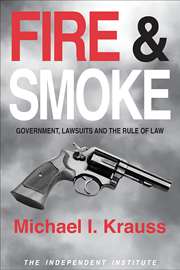By now, everyone who drives has heard that there is a problem with some tires on some sport utility vehicles. Most of the tires are Firestones (a unit of Bridgestone of Japan), and most of the vehicles are Ford Explorers. Most of the problems consist of blowouts caused by tread separation of the rear tires, resulting in rollovers. It seems that almost 100 people have lost their lives in such accidents.
The problem was spotted entirely by private enterprise (analysts at Ford and at State Farm Insurance, for the most part). But the government is stepping in. Congressmen are furious. Millions of tires have been recalled and hundreds of thousands of motorists are panicked. And in a triumph of chutzpah NHTSA, caught blithely napping, maintains that if only it had a lot more money and power this would never happen again.
(Astute readers will have noticed a pattern here. If a federal agency detects a problem, this means that it needs more resources and regulatory powers to reward its good behavior and enhance its expertise further. If the agency’s gross incompetence is shown, however, that means that it needs more resources and regulatory powers to remedy the situation.)
Detailed investigations are of course ongoing. But enough of the dust has settled that it seems possible to offer unbiased and at least tentative answers to the following questions: What happened? Who is to blame? How does current law deal with the situation? Do we need more laws: notably, does NHTSA need more powers to combat such problems?
1. What happened? As best we can tell, the two steel belts glued to the rubber on certain models of Firestone tires are separating in high temperatures and at relatively high speeds. This is almost certainly due to a manufacturing defect in these tires. The weakened tires, after heavy use and if grossly under-inflated (Americans are notorious about ignoring tire pressure), evidently present a significant risk of tread separation. Firestone has virtually admitted as much. Millions of tires supplied in the same sizes, with the same recommended tire pressure, and during the same years by Goodyear have not suffered suspicious numbers of failures.
2. Who is to blame? Anti-SUV forces have, as expected, blasted Ford because of the rollovers. And of course SUVs, with their higher center of gravity, are more prone to rollovers in case of rear tire failure than are passenger cars. But the death rate in rollovers for Explorers is over 40 percent lower than for Chevrolet Blazers, even though the Blazer has not been victimized by tire problems. And the overall death rate in Explorers is lower than the average for all motor vehicles – weight and height may increase some highway risks, but they obviously decrease many others. In sum it appears that a combination of defectively weak tires and poor maintenance habits best explains these accidents.
3. How does current law deal with these tragedies? The Firestone tires were probably "defective and unreasonably dangerous." Clearly Firestone (that is, Bridgestone) is liable for injuries caused by these defects. Ford is also liable if the tires involved in an accident were original equipment.
This liability is independent of the automobile’s warranty – a new car warranty typically does not cover tires, but the car’s manufacturer is nonetheless liable for dangerous tire defects under product liability law.
In addition to having to compensate victims, Firestone will be subject to punitive damages and criminal prosecution if it turns out that it was or should clearly have been aware of the defects and failed to notify Ford and individual car owners. State attorneys general are presently investigating this question, and there is every reason to believe their investigation will be thorough. It should be noted that there is little evidence at this point that Ford hid any relevant information – indeed, Ford’s offer to replace existing tires and to locate 34 competing brands goes above and beyond its warranty obligations.
4. Do we need more federal laws? Perhaps it is unrealistic to hope that Congress, in this election year, will resist the temptation to add to the already ridiculous number of federal regulatory mandates. State product liability law and state criminal sanctions are perfectly adequate to deal with the Firestone/Ford problem. And the market can be devastatingly effective: the Firestone brand is dead in the water, Bridgestone stockholders have lost half their investment and are now screaming for the heads of their company’s managers; Michelin and Goodyear are filling newspapers with ads demonstrating the safety of their products. Federal regulations are costly, and part of their cost is often measured in perverse consequences. Remember, SUV tires have a "deep-tread" design, and this has tricked some people into driving them for many years, even after they have weakened. Additional federal mandates will further increase the price of tires; this will inevitably lead even more people to delay replacing old tires, thereby causing even more deaths.
NHTSA, the agency responsible for minimum fuel economy standards (found by a court to have likely cost many lives by forcing manufacturers to produce light, dangerous cars) and for illegal-to-disable, baby-killing airbags, does not deserve to be rewarded for its asleep-at-the-switch approach to the tire problem.
The Feds Eye Firestone
More Regulations Would Not Save Lives
Also published in The Washington Times
Michael I. Krauss is a law professor at George Mason University.
Comments
Before posting, please read our Comment Policy.







